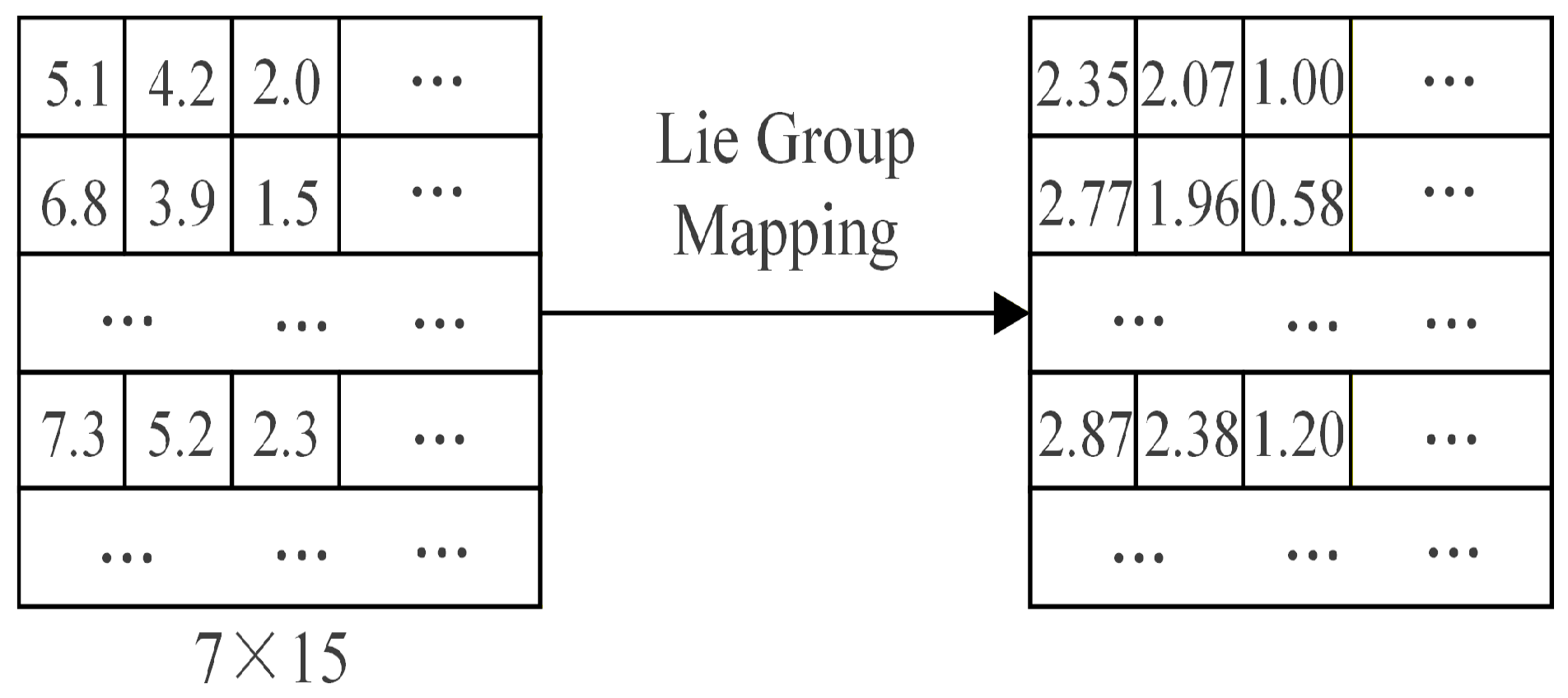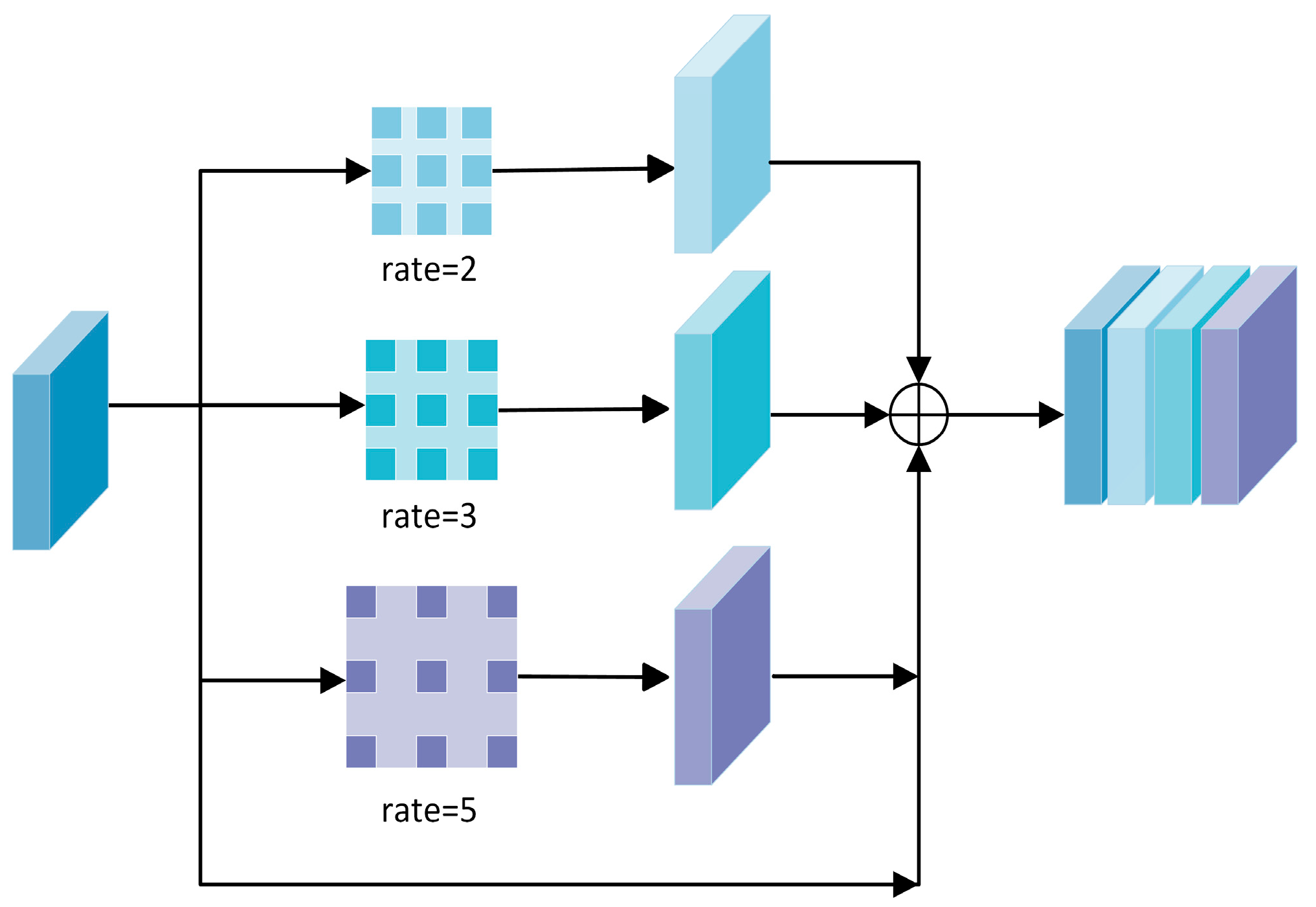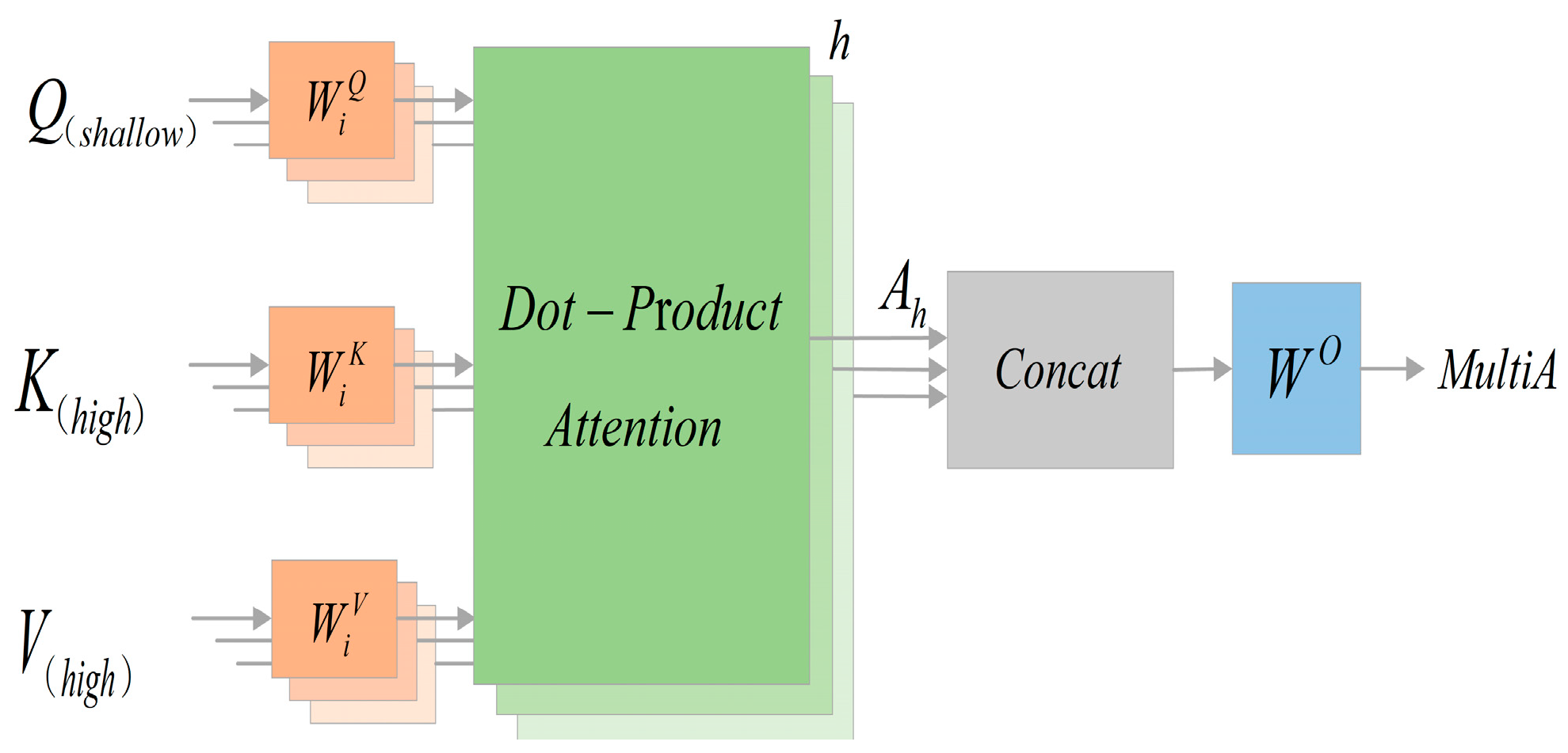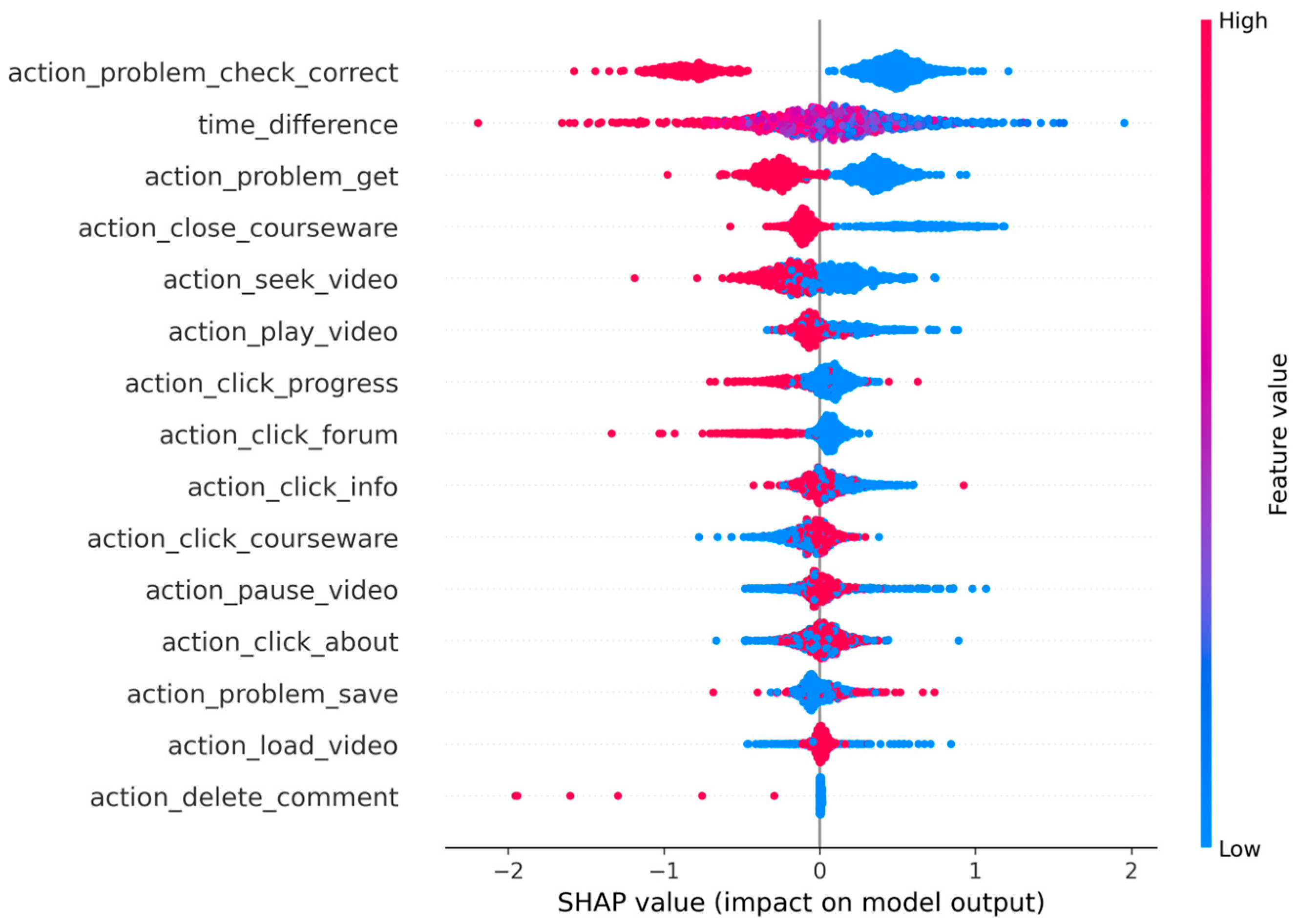1. Introduction
Recently, Massive Open Online Courses (MOOCs) have emerged as an innovative teaching paradigm. The internet facilitates new avenues for knowledge acquisition and innovative learning methods, thereby significantly transforming the educational sector [
1,
2]. High dropout rates continue to pose a significant challenge to the advancement of MOOCs, despite the provision of enhanced platforms and learning pathways for learners. Prior studies demonstrate that completion rates for MOOCs typically remain under 10% [
3]. Identifying learners at risk of dropout allows instructors to implement early interventions through personalized guidance, thus decreasing the likelihood of dropout. A critical area of research in online education involves analyzing learner behavior to identify key factors contributing to dropout rates, improving MOOC completion rates, and enhancing the overall quality of online education [
4]. Accurate dropout prediction is crucial for advancing the sustainable and high-quality development of MOOCs.
Current models for predicting dropout rates in MOOCs are categorized into three primary types [
5]: (1) models based on traditional machine learning, (2) models based on deep learning, and (3) models based on attention mechanisms. Conventional machine learning models focus on the clickstream data of learners, framing dropout prediction as a regression problem and employing classifiers as predictive models for dropout [
6]. Yujiao et al. [
7] introduced a feature weighting method that integrates Pearson correlation with a Support Vector Machine (SVM) for modeling purposes. The experimental results across various datasets indicated that by differentiating the significance of distinct behavioral features, this model surpassed traditional equal-weight feature models in predictive performance. Chen et al. [
8] introduced a non-iterative hybrid algorithm that integrates decision trees with extreme learning machines, employing entropy theory to enhance model structure optimization. This successfully reduced behavioral variance and addressed training time challenges in predicting MOOC dropout. Behr et al. [
9] employed a Random Forest (RF) approach, grounded in conditional inference trees, which integrates variables from learners’ early university experiences to predict dropout rates in extensive higher education datasets. Despite these advancements, traditional machine learning approaches often encounter limitations in processing complex data, frequently failing to identify deep, underlying patterns.
In this context, researchers have suggested methods based on deep learning, which utilize their capacity for automatic feature learning and have been extensively employed for dropout prediction. Xia and Qi [
10] developed a multi-layer fully convolutional network aimed at predicting dropout. Niu et al. [
11] introduced a new neural network model, CNNAE-LSTM, which integrates a convolutional autoencoder with a Long Short-Term Memory (LSTM) network to extract essential features and conduct time series modeling. Cam et al. [
12] designed DeepS3VM, a hybrid model for dropout prediction. This model employs a Recurrent Neural Network (RNN) to analyze trends in learner behavior over time and integrates SVM for the classification of learners at risk of dropout. Chen et al. [
13] addressed the challenges of insufficient early-stage data and sample imbalance by integrating a Convolutional Neural Network (CNN) with LSTM for dropout prediction, enhancing prediction accuracy. Deep learning methods predominantly utilize convolutional operations that emphasize local features, resulting in difficulties in capturing long-range dependencies and constraining their capacity to process global context.
With the continuous development of related research, scholars have introduced attention mechanisms into dropout prediction models. Attention mechanisms have increasingly been employed as practical approaches in dropout prediction owing to their ability to model long-range dependencies. Kumar et al. [
14] developed the EDLN model, which incorporates various deep learning modules and utilizes a static attention mechanism to allocate attention weights to high-dimensional behavioral vectors. Wen and Juan [
15] developed a model that combines self-attention mechanisms, a CNN, and LSTM, where the self-attention mechanism dynamically weights features and captures temporal correlations among them. Lee et al. [
16] presented a deep learning model called DAS, which employs the attention mechanism of the Transformer to thoroughly examine the continuous behavioral changes in learners throughout a single learning session, ultimately forecasting the likelihood of session completion by the learners. In addition, Chen et al. [
17] utilized a multi-head self-attention mechanism to forecast learner performance.
Despite the satisfactory results achieved by the aforementioned models, several challenges persist:
Existing models predominantly utilize fixed convolution kernels, leading to constrained feature information extraction. The use of large-scale convolution kernels would significantly increase feature dimensions, thereby increasing the computational burden.
Current attention mechanisms do not adequately capture the behavioral patterns of learners, especially in terms of temporal correlations. This method elevates computational demands but diminishes prediction accuracy.
Most existing models exhibit intricate architectures, elevated feature dimensions, and significant computational complexity.
This study proposes a Lie Group-based feature context-local fusion attention model to predict MOOCs dropout and address key challenges. First, the model initially projects data samples onto a Lie Group manifold space, extracting multiscale feature maps through parallel dilated convolution. Second, it introduces a context-local feature fusion attention mechanism designed to capture features and their correlations across temporal and feature dimensions. Finally, it forecasts dropout rates. This study’s main contributions are summarized below:
This study introduces a feature extraction method employing Lie Group machine learning, leveraging the computational advantages of Lie Groups and Lie algebras to effectively minimize feature dimensions and model complexity. Unlike conventional vector spaces that treat learning behaviors as discrete points, the manifold structure of Lie Groups can characterize the temporal continuity and non-linear evolutionary features of these behaviors.
We present a context-local feature fusion attention mechanism that integrates contextual and local features. The mechanism empowers the model to more effectively extract region-specific details and contextual features while minimizing irrelevant features. Furthermore, it facilitates cross-layer interaction between shallow and high-level features, enhances the diversity of feature representations, and thereby improves the model’s prediction accuracy.
Our model architecture utilizes mechanisms, including Lie Group and attention, to minimize feature dimensions efficiently. This method enhances both prediction accuracy and computational performance. Comprehensive experiments utilizing the publicly accessible XuetangX dataset demonstrate that our model outperforms leading methodologies in feature extraction and classification accuracy.
Author Contributions
Y.L. conceived and designed the study; methodology was jointly developed by Y.L. and C.X.; D.Y. carried out the software implementation; Y.L. and C.X. prepared the initial draft; C.X. was responsible for manuscript revision and editing; and Y.S. secured the funding. All authors have read and agreed to the published version of the manuscript.
Funding
This research was funded by the National Natural Science Foundation of China (62262074), the Science and Technology Plan Project of Yunnan Province (202405AC350083), the National Natural Science Foundation of China (62363015), the National Natural Science Foundation of China (42261068), and the Natural Science Foundation of Jiangxi Province (20242BAB25112).
Data Availability Statement
Conflicts of Interest
The authors declare no conflicts of interest.
References
- Moreno-Marcos, P.M.; Muñoz-Merino, P.J.; Maldonado-Mahauad, J.; Pérez-Sanagustín, M.; Alario-Hoyos, C.; Delgado Kloos, C. Temporal Analysis for Dropout Prediction Using Self-Regulated Learning Strategies in Self-Paced MOOCs. Comput. Educ. 2020, 145, 103728. [Google Scholar] [CrossRef]
- Fidalgo-Blanco, Á.; Sein-Echaluce, M.L.; García-Peñalvo, F.J. From Massive Access to Cooperation: Lessons Learned and Proven Results of a Hybrid xMOOC/cMOOC Pedagogical Approach to MOOCs. Int. J. Educ. Technol. High. Educ. 2016, 13, 24. [Google Scholar] [CrossRef]
- De Freitas, S.I.; Morgan, J.; Gibson, D. Will MOOCs Transform Learning and Teaching in Higher Education? Engagement and Course Retention in Online Learning Provision. Br. J. Educ. Technol. 2015, 46, 455–471. [Google Scholar] [CrossRef]
- Rawat, S.; Kumar, D.; Kumar, P.; Khattri, C. A Systematic Analysis Using Classification Machine Learning Algorithms to Understand Why Learners Drop out of MOOCs. Neural Comput. Appl. 2021, 33, 14823–14835. [Google Scholar] [CrossRef]
- Xu, C.; Zhu, G.; Ye, J.; Shu, J. Educational Data Mining: Dropout Prediction in XuetangX MOOCs. Neural Process. Lett. 2022, 54, 2885–2900. [Google Scholar] [CrossRef]
- Jin, C. Dropout Prediction Model in MOOC Based on Clickstream Data and Student Sample Weight. Soft Comput. 2021, 25, 8971–8988. [Google Scholar] [CrossRef]
- Yujiao, Z.; Ang, L.W.; Shaomin, S.; Palaniappan, S. Dropout Prediction Model for College Students in MOOCs Based on Weighted Multi-Feature and SVM. J. Inform. Web Eng. 2023, 2, 29–42. [Google Scholar] [CrossRef]
- Chen, J.; Feng, J.; Sun, X.; Wu, N.; Yang, Z.; Chen, S. MOOC Dropout Prediction Using a Hybrid Algorithm Based on Decision Tree and Extreme Learning Machine. Math. Probl. Eng. 2019, 2019, 8404653. [Google Scholar] [CrossRef]
- Behr, A.; Giese, M.; Teguim, K.H.D.; Theune, K. Early Prediction of University Dropouts—A Random Forest Approach. Jahrb. Natl. Stat. 2020, 240, 743–789. [Google Scholar] [CrossRef]
- Xia, X.; Qi, W. Dropout Prediction and Decision Feedback Supported by Multi Temporal Sequences of Learning Behavior in MOOCs. Int. J. Educ. Technol. High. Educ. 2023, 20, 32. [Google Scholar] [CrossRef]
- Niu, K.; Lu, G.; Peng, X.; Zhou, Y.; Zeng, J.; Zhang, K. CNN Autoencoders and LSTM-Based Reduced Order Model for Student Dropout Prediction. Neural Comput. Appl. 2023, 35, 22341–22357. [Google Scholar] [CrossRef]
- Nguyen Thi Cam, H.; Sarlan, A.; Arshad, N.I. A Hybrid Model Integrating Recurrent Neural Networks and the Semi-Supervised Support Vector Machine for Identification of Early Student Dropout Risk. PeerJ Comput. Sci. 2024, 10, e2572. [Google Scholar] [CrossRef]
- Chen, H.-C.; Prasetyo, E.; Tseng, S.-S.; Putra, K.T.; Prayitno; Kusumawardani, S.S.; Weng, C.-E. Week-Wise Student Performance Early Prediction in Virtual Learning Environment Using a Deep Explainable Artificial Intelligence. Appl. Sci. 2022, 12, 1885. [Google Scholar] [CrossRef]
- Kumar, G.; Singh, A.; Sharma, A. Ensemble Deep Learning Network Model for Dropout Prediction in MOOCs. Int. J. Electr. Comput. Eng. Syst. 2023, 14, 187–196. [Google Scholar] [CrossRef]
- Wen, X.; Juan, H. Early Prediction of MOOC Dropout in Self-Paced Students Using Deep Learning. Interact. Learn. Environ. 2024, 32, 7102–7119. [Google Scholar] [CrossRef]
- Lee, Y.; Shin, D.; Loh, H.; Lee, J.; Chae, P.; Cho, J.; Park, S.; Lee, J.; Baek, J.; Kim, B.; et al. Deep Attentive Study Session Dropout Prediction in Mobile Learning Environment. arXiv 2021, arXiv:2002.11624. [Google Scholar] [CrossRef]
- Chen, Y.; Wei, G.; Liu, J.; Chen, Y.; Zheng, Q.; Tian, F.; Zhu, H.; Wang, Q.; Wu, Y. A Prediction Model of Student Performance Based on Self-Attention Mechanism. Knowl. Inf. Syst. 2023, 65, 733–758. [Google Scholar] [CrossRef]
- Jin, C. MOOC Student Dropout Prediction Model Based on Learning Behavior Features and Parameter Optimization. Interact. Learn. Environ. 2023, 31, 714–732. [Google Scholar] [CrossRef]
- Masood, S.W.; Gogoi, M.; Begum, S.A. Optimised SMOTE-Based Imbalanced Learning for Student Dropout Prediction. Arab. J. Sci. Eng. 2025, 50, 7165–7179. [Google Scholar] [CrossRef]
- Rebelo Marcolino, M.; Reis Porto, T.; Thompsen Primo, T.; Targino, R.; Ramos, V.; Marques Queiroga, E.; Munoz, R.; Cechinel, C. Student Dropout Prediction through Machine Learning Optimization: Insights from Moodle Log Data. Sci. Rep. 2025, 15, 9840. [Google Scholar] [CrossRef]
- Blundo, C.; Loia, V.; Orciuoli, F. A Time-Aware Approach for MOOC Dropout Prediction Based on Rule Induction and Sequential Three-Way Decisions. IEEE Access 2023, 11, 113189–113198. [Google Scholar] [CrossRef]
- Kim, S.; Choi, E.; Jun, Y.-K.; Lee, S. Student Dropout Prediction for University with High Precision and Recall. Appl. Sci. 2023, 13, 6275. [Google Scholar] [CrossRef]
- Alghamdi, S.; Soh, B.; Li, A. ISELDP: An Enhanced Dropout Prediction Model Using a Stacked Ensemble Approach for In-Session Learning Platforms. Electronics 2025, 14, 2568. [Google Scholar] [CrossRef]
- Qiu, L.; Liu, Y.; Liu, Y. An Integrated Framework With Feature Selection for Dropout Prediction in Massive Open Online Courses. IEEE Access 2018, 6, 71474–71484. [Google Scholar] [CrossRef]
- Kabathova, J.; Drlik, M. Towards Predicting Student’s Dropout in University Courses Using Different Machine Learning Techniques. Appl. Sci. 2021, 11, 3130. [Google Scholar] [CrossRef]
- Shou, Z.; Chen, P.; Wen, H.; Liu, J.; Zhang, H. MOOC Dropout Prediction Based on Multidimensional Time-Series Data. Math. Probl. Eng. 2022, 2022, 2213292. [Google Scholar] [CrossRef]
- Zhang, X.; Wang, X.; Zhao, J.; Zhang, B.; Zhang, F. IC-BTCN: A Deep Learning Model for Dropout Prediction of MOOCs Students. IEEE Trans. Educ. 2024, 67, 974–982. [Google Scholar] [CrossRef]
- Alruwais, N.M. Deep FM-Based Predictive Model for Student Dropout in Online Classes. IEEE Access 2023, 11, 96954–96970. [Google Scholar] [CrossRef]
- Zheng, Y.; Gao, Z.; Wang, Y.; Fu, Q. MOOC Dropout Prediction Using FWTS-CNN Model Based on Fused Feature Weighting and Time Series. IEEE Access 2020, 8, 225324–225335. [Google Scholar] [CrossRef]
- Tang, X.; Zhang, H.; Zhang, N.; Yan, H.; Tang, F.; Zhang, W. Dropout Rate Prediction of Massive Open Online Courses Based on Convolutional Neural Networks and Long Short-Term Memory Network. Mob. Inf. Syst. 2022, 2022, 8255965. [Google Scholar] [CrossRef]
- Talebi, K.; Torabi, Z.; Daneshpour, N. Ensemble Models Based on CNN and LSTM for Dropout Prediction in MOOC. Expert Syst. Appl. 2024, 235, 121187. [Google Scholar] [CrossRef]
- Mubarak, A.A.; Cao, H.; Hezam, I.M. Deep Analytic Model for Student Dropout Prediction in Massive Open Online Courses. Comput. Electr. Eng. 2021, 93, 107271. [Google Scholar] [CrossRef]
- Zheng, Y.; Shao, Z.; Deng, M.; Gao, Z.; Fu, Q. MOOC Dropout Prediction Using a Fusion Deep Model Based on Behaviour Features. Comput. Electr. Eng. 2022, 104, 108409. [Google Scholar] [CrossRef]
- Fu, Q.; Gao, Z.; Zhou, J.; Zheng, Y. CLSA: A Novel Deep Learning Model for MOOC Dropout Prediction. Comput. Electr. Eng. 2021, 94, 107315. [Google Scholar] [CrossRef]
- Yin, S.; Lei, L.; Wang, H.; Chen, W. Power of Attention in MOOC Dropout Prediction. IEEE Access 2020, 8, 202993–203002. [Google Scholar] [CrossRef]
- Liu, H.; Chen, X.; Zhao, F. Learning Behavior Feature Fused Deep Learning Network Model for MOOC Dropout Prediction. Educ. Inf. Technol. 2024, 29, 3257–3278. [Google Scholar] [CrossRef]
- Liang, G.; Qian, Z.; Wang, S.; Hao, P. MOOCs Dropout Prediction via Classmates Augmented Time-Flow Hybrid Network. In Neural Information Processing; Luo, B., Cheng, L., Wu, Z.-G., Li, H., Li, C., Eds.; Communications in Computer and Information Science; Springer Nature: Singapore, 2024; Volume 1969, pp. 405–416. ISBN 978-981-99-8183-0. [Google Scholar]
- Capuano, N.; Caballé, S.; Conesa, J.; Greco, A. Attention-Based Hierarchical Recurrent Neural Networks for MOOC Forum Posts Analysis. J. Ambient. Intell. Humaniz. Comput. 2021, 12, 9977–9989. [Google Scholar] [CrossRef]
- Sebbaq, H.; El Faddouli, N. An Explainable Attention-Based Bidirectional GRU Model for Pedagogical Classification of MOOCs. Interact. Technol. Smart Educ. 2022, 19, 396–421. [Google Scholar] [CrossRef]
- Al-azazi, F.A.; Ghurab, M. ANN-LSTM: A Deep Learning Model for Early Student Performance Prediction in MOOC. Heliyon 2023, 9, e15382. [Google Scholar] [CrossRef]
- Xu, C.; Zhu, G.; Shu, J. A Combination of Lie Group Machine Learning and Deep Learning for Remote Sensing Scene Classification Using Multi-Layer Heterogeneous Feature Extraction and Fusion. Remote Sens. 2022, 14, 1445. [Google Scholar] [CrossRef]
- Galimberti, C.L.; Furieri, L.; Xu, L.; Ferrari-Trecate, G. Hamiltonian Deep Neural Networks Guaranteeing Non-Vanishing Gradients by Design. IEEE Trans. Autom. Control. 2023, 68, 3155–3162. [Google Scholar] [CrossRef]
- He, K.; Zhang, X.; Ren, S.; Sun, J. Deep Residual Learning for Image Recognition. In Proceedings of the 2016 IEEE Conference on Computer Vision and Pattern Recognition (CVPR), Las Vegas, NV, USA, 27–30 June 2016; IEEE: Piscataway, NJ, USA; pp. 770–778. [Google Scholar]
- Xu, C.; Zhu, G.; Shu, J. A Lightweight and Robust Lie Group-Convolutional Neural Networks Joint Representation for Remote Sensing Scene Classification. Trans. Geosci. Remote Sens. 2022, 60, 1–15. [Google Scholar] [CrossRef]
- Xu, C.; Zhu, G.; Shu, J. Robust Joint Representation of Intrinsic Mean and Kernel Function of Lie Group for Remote Sensing Scene Classification. IEEE Geosci. Remote Sens. Lett. 2021, 18, 796–800. [Google Scholar] [CrossRef]
- Li, K.; Wang, Y.; Zhang, J.; Gao, P.; Song, G.; Liu, Y.; Li, H.; Qiao, Y. UniFormer: Unifying Convolution and Self-Attention for Visual Recognition. IEEE Trans. Pattern Anal. Mach. Intell. 2023, 45, 12581–12600. [Google Scholar] [CrossRef]
- Apostolidis, E.; Balaouras, G.; Mezaris, V.; Patras, I. Combining Global and Local Attention with Positional Encoding for Video Summarization. In Proceedings of the 2021 IEEE International Symposium on Multimedia (ISM), Naple, Italy, 29 November–1 December 2021; IEEE: Piscataway, NJ, USA; pp. 226–234. [Google Scholar]
- Vaswani, A.; Shazeer, N.; Parmar, N.; Uszkoreit, J.; Jones, L.; Gomez, A.N.; Kaiser, Ł.; Polosukhin, I. Attention Is All You Need. In Advances in Neural Information Processing Systems; The MIT Press: Cambridge, MA, USA, 2017. [Google Scholar]
- Ghazimoghadam, S.; Hosseinzadeh, S.A.A. A Novel Unsupervised Deep Learning Approach for Vibration-Based Damage Diagnosis Using a Multi-Head Self-Attention LSTM Autoencoder. Measurement 2024, 229, 114410. [Google Scholar] [CrossRef]
- Feng, W.; Tang, J.; Liu, T.X. Understanding Dropouts in MOOCs. In Proceedings of the AAAI Conference on Artificial Intelligence, Honolulu, HI, USA, 27 January–1 February 2019; Volume 33, pp. 517–524. [Google Scholar] [CrossRef]
- Pan, T.; Feng, G.; Liu, X.; Wu, W. Using Feature Interaction for Mining Learners’ Hidden Information in MOOC Dropout Prediction. In Augmented Intelligence and Intelligent Tutoring Systems; Lecture Notes in Computer Science; Frasson, C., Mylonas, P., Troussas, C., Eds.; Springer Nature: Cham, Switzerland, 2023; Volume 13891, pp. 507–517. ISBN 978-3-031-32882-4. [Google Scholar]
- Basnet, R.B.; Johnson, C.; Doleck, T. Dropout Prediction in Moocs Using Deep Learning and Machine Learning. Educ. Inf. Technol. 2022, 27, 11499–11513. [Google Scholar] [CrossRef]
- Pan, F.; Huang, B.; Zhang, C.; Zhu, X.; Wu, Z.; Zhang, M.; Ji, Y.; Ma, Z.; Li, Z. A Survival Analysis Based Volatility and Sparsity Modeling Network for Student Dropout Prediction. PLoS ONE 2022, 17, e0267138. [Google Scholar] [CrossRef]
- Niu, K.; Zhou, Y.; Lu, G.; Tai, W.; Zhang, K. PMCT: Parallel Multiscale Convolutional Temporal Model for MOOC Dropout Prediction. Comput. Electr. Eng. 2023, 112, 108989. [Google Scholar] [CrossRef]
| Disclaimer/Publisher’s Note: The statements, opinions and data contained in all publications are solely those of the individual author(s) and contributor(s) and not of MDPI and/or the editor(s). MDPI and/or the editor(s) disclaim responsibility for any injury to people or property resulting from any ideas, methods, instructions or products referred to in the content. |
© 2025 by the authors. Licensee MDPI, Basel, Switzerland. This article is an open access article distributed under the terms and conditions of the Creative Commons Attribution (CC BY) license (https://creativecommons.org/licenses/by/4.0/).












